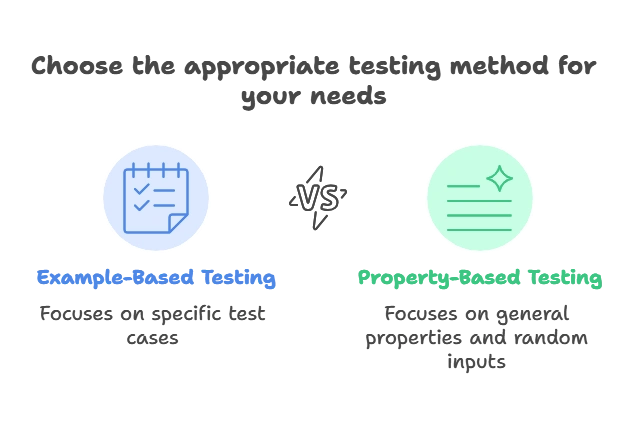Property-Based Testing with gocheck
Property-based testing is a testing technique where you define properties or invariants that should hold true for your code, and then generate random inputs to test those properties. In this chapter, we'll explore property-based testing in Go using the gocheck framework.
Understanding Property-Based Testing
Property-based testing differs from traditional example-based testing by focusing on general properties of the code rather than specific test cases. It generates random inputs and verifies that the properties hold true for those inputs, helping to uncover edge cases and corner cases.
Introduction to gocheck
gocheck is a popular testing framework for Go that provides support for property-based testing. It allows you to define test suites, test cases, and properties using a fluent and expressive syntax.

Getting Started with gocheck
This chapter covers the basics of setting up gocheck and writing simple property-based tests.
Installing gocheck
To install gocheck, you can use the go get command:
go get gopkg.in/check.v1
Writing Your First Property-Based Test
Let’s write a simple property-based test using gocheck to verify the commutative property of addition:
package mypackage_test
import (
"math/rand"
"testing"
. "gopkg.in/check.v1"
)
// Define a test suite
func Test(t *testing.T) { TestingT(t) }
type MySuite struct{}
var _ = Suite(&MySuite{})
// Property-based test for commutative property of addition
func (s *MySuite) TestAdditionCommutative(c *C) {
// Define property: a + b = b + a
property := func(a, b int) bool {
return a+b == b+a
}
// Generate random inputs and test property
c.Assert(QuickCheck(property), Equals, "")
}
- We define a test suite using gocheck’s
Suitefunction. - We define a property-based test
TestAdditionCommutativethat checks the commutative property of addition. - Inside the test function, we define the property as a function that takes two integers
aandband returns true ifa + bequalsb + a. - We use
QuickCheckto generate random inputs and test the property. If the property holds true for all generated inputs, the test passes.
Advanced Property-Based Testing Techniques
This chapter explores advanced techniques and best practices for property-based testing with gocheck.
Custom Generators
Custom generators allow you to create complex and customized input data for testing specific properties. This section demonstrates how to define custom generators for various data types.
Testing Sorting Algorithms
Suppose we want to test the property that applying a sorting algorithm to a list should result in a sorted list. We can define a custom generator for slices of integers and test this property.
// Define a custom generator for slices of integers
func (s *MySuite) TestSortingAlgorithm(c *C) {
property := func(input []int) bool {
sorted := make([]int, len(input))
copy(sorted, input)
sort.Ints(sorted)
// Test property: applying sorting algorithm to the input should result in a sorted list
return reflect.DeepEqual(sorted, mySortingAlgorithm(input))
}
// Generate random inputs and test property
c.Assert(QuickCheck(property), Equals, "")
}
Testing JSON Serialization
Suppose we want to test the property that serializing a Go struct to JSON and then deserializing it back should result in the original struct. We can define a custom generator for the Go struct and test this property.
// Define a custom generator for a Go struct
func (s *MySuite) TestJSONSerialization(c *C) {
property := func(input MyStruct) bool {
serialized, err := json.Marshal(input)
if err != nil {
return false
}
var deserialized MyStruct
err = json.Unmarshal(serialized, &deserialized)
if err != nil {
return false
}
// Test property: serializing and deserializing the input struct should result in the original struct
return reflect.DeepEqual(input, deserialized)
}
// Generate random inputs and test property
c.Assert(QuickCheck(property), Equals, "")
}
Shrinking
Shrinking is a technique used to simplify failing test cases by reducing the input values to the smallest possible failing case. This section demonstrates how gocheck automatically performs shrinking to simplify failing test cases.
Shrinking Failing Test Cases
Suppose we have a property-based test that checks if the sum of two integers is always greater than the larger of the two integers. If the property fails for a specific input, gocheck will automatically try to shrink the input values to find the smallest failing case.
// Property-based test: sum of two integers is always greater than the larger of the two integers
func (s *MySuite) TestSumGreaterThanLargerInteger(c *C) {
property := func(a, b int) bool {
sum := a + b
larger := a
if b > a {
larger = b
}
// Test property: sum should be greater than the larger integer
return sum > larger
}
// Generate random inputs and test property
c.Assert(QuickCheck(property), Equals, "")
}
In this example, if the property fails for a specific input (e.g., a = 10, b = 5), gocheck will automatically shrink the input values to find the smallest failing case (e.g., a = 1, b = 0). This helps to identify the root cause of the failure more effectively.
By leveraging custom generators and automatic shrinking, you can perform more advanced property-based testing with gocheck, ensuring comprehensive coverage and reliability of your Go code.
In this chapter, we explored property-based testing with gocheck, a powerful technique for identifying edge cases and corner cases in your code. By defining properties and using random input generation, you can create more robust and reliable tests for your Go applications. Property-based testing complements traditional example-based testing, providing additional confidence in the correctness of your code. Happy coding !❤️
